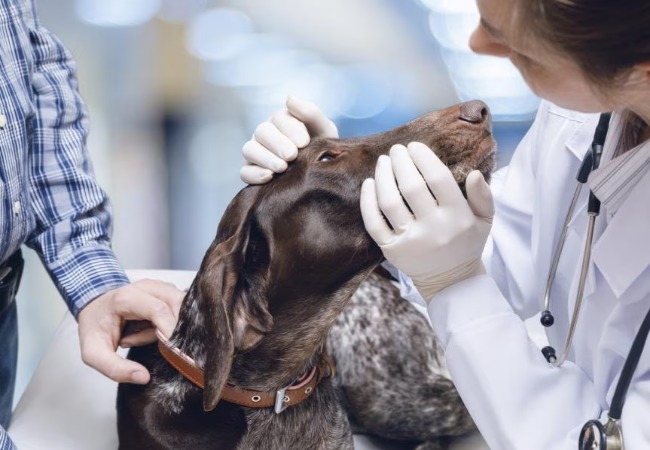Nasal Polyps in Dogs – Vet‑Led Guide 2025 🐶👃🩺

In this article
Nasal Polyps in Dogs – Vet‑Led Guide 2025 🐶👃🩺
By Dr. Duncan Houston BVSc
Hello, I’m Dr Duncan Houston, BVSc, founder of Ask A Vet. Nasal polyps—benign mucosal overgrowths—can lead to persistent sneezing, discharge, stertor, or even nosebleeds in dogs. Though non-cancerous, they often require treatment due to breathing discomfort and recurrence risk. In this 2025 guide, I’ll explain causes, signs, diagnostic steps (rhinoscopy & imaging), treatment options (endoscopic removal vs rhinotomy), recurrence risks, and follow‑up care to help your dog breathe freely. Let’s dive in. 💙
📘 What Are Nasal Polyps?
Nasal polyps are benign, stalked growths of inflamed nasal mucosa, arising from chronic rhinitis or sinus inflammation. They may protrude into the nasal cavity, causing airflow obstruction and local tissue irritation.
🚩 Causes & Risk Factors
- Chronic rhinitis/sinusitis: due to bacterial, fungal, allergic, or viral causes.
- Inhaled irritants or foreign bodies: e.g. grass awns, smoke, pollen.
- Brachycephalic conformation: altered airflow predisposes to inflammation.
- Younger dogs: Polyps occur more often in younger vs age-related tumors.
- Breeds: dolichocephalic dogs (Greyhounds, Collies, Dachshunds) and possibly Labradors may be predisposed.
🧠 Who Can Be Affected?
Unlike nasal cancers seen in older dogs, nasal polyps often affect younger, otherwise healthy individuals. Any breed can be affected, though those with chronic nasal inflammation are at higher risk.
🚨 Clinical Signs & Red Flags
- Sneezing and chronic nasal discharge—usually clear but may be bloody.
- Stertor or congested breathing sounds.
- Decreased sense of smell and occasional nosebleeds.
- Visible pink tissue protruding from nostril (rarer).
- Facial discomfort or pawing at the nose.
- Sometimes, secondary infections or turbinate bone destruction can occur.
🔍 Diagnostic Steps
- History & exam: look for persistent nasal signs, sniffing, discharge, bleeding.
- Bloodwork: CBC to look for infection; generally normal.
- Rhinoscopy: gold-standard evaluation; allows visualization and biopsy.
- Imaging: CT or skull radiographs may show turbinate loss or space-occupying lesions.
- Biopsy & histopathology: confirms polyp vs neoplasia and rules out malignancy.
💉 Treatment Options
1. Endoscopic Debulking
- Visualization via endoscope; polyps removed using laser or forceps.
- A study of 23 dogs showed endoscopic debulking with a laser & forceps was more effective than steroids alone.
- Usually performed under general anesthesia—with or without subsequent rhinoscopic surveillance.
2. Rhinotomy (Open Surgery)
Reserved for polyps inaccessible endoscopically. Involves removing nasal bone and polyp stalk. Provides thorough removal but is more invasive and carries higher risk. Recurrence possible.
3. Medical Management
- Steroids (prednisone) or NSAIDs like piroxicam may reduce polyp size, but often not definitive.
- Antibiotics for secondary infections that accompany polyp growth.
- Radiation therapy is rarely used but may be an adjunct if surgery isn't possible.
🏡 Post-Op Care & Monitoring
- Expect mild bloody discharge for 1–2 weeks; use Elizabethan collar to prevent trauma.
- Administer prescribed antibiotics and anti‑inflammatories.
- Follow-up rhinoscopy or CT at 4–6 weeks to check for recurrence.
- Manage underlying inflammation via allergy control, environment modification, and infection treatment.
- Monitor for sneezing, discharge, or stertor—recurrence may occur.
📅 Prognosis & Long-Term Outlook
- Many dogs breathe well after timely removal; recurrence rates vary (some relapse after months or years).
- Endoscopic removal has lower recurrence vs simple traction-only techniques.
- Rhinotomy can be effective for deep lesions but may not prevent scar formation.
- Recurrence is often tied to persistent nasal inflammation—requires long-term management.
- With proper care and follow-up, most dogs enjoy long-term relief and improved breathing comfort.
🐾 Role of Ask A Vet
For immediate guidance on post-op care, breathing support, or comfort strategies, connect anytime via Ask A Vet. Use nasal hygiene tools,
✨ Key Takeaways
- Nasal polyps are benign mucosal growths from chronic nasal inflammation.
- Symptoms include sneezing, discharge, stertor, and occasional nosebleeds.
- Diagnosis requires rhinoscopy, imaging, and biopsy.
- Endoscopic removal (laser/forceps) is effective; open surgery for deep follicles.
- Post‑op care, anti‑inflammatories, and infection control are essential to prevent recurrence.
- Long-term outcome is good with vigilant follow-up—many dogs regain normal nasal function.
- If nasal signs persist, seek vet help or call Ask A Vet—your dog deserves clear breathing and comfort. 🐾❤️
If your dog is sneezing persistently, has nasal discharge, noisy breathing, or you see odd tissue in their nostrils—act fast. Contact your veterinarian or Ask A Vet. Early treatment can bring comfort and clarity back to their nose—and to your life. 🩺






